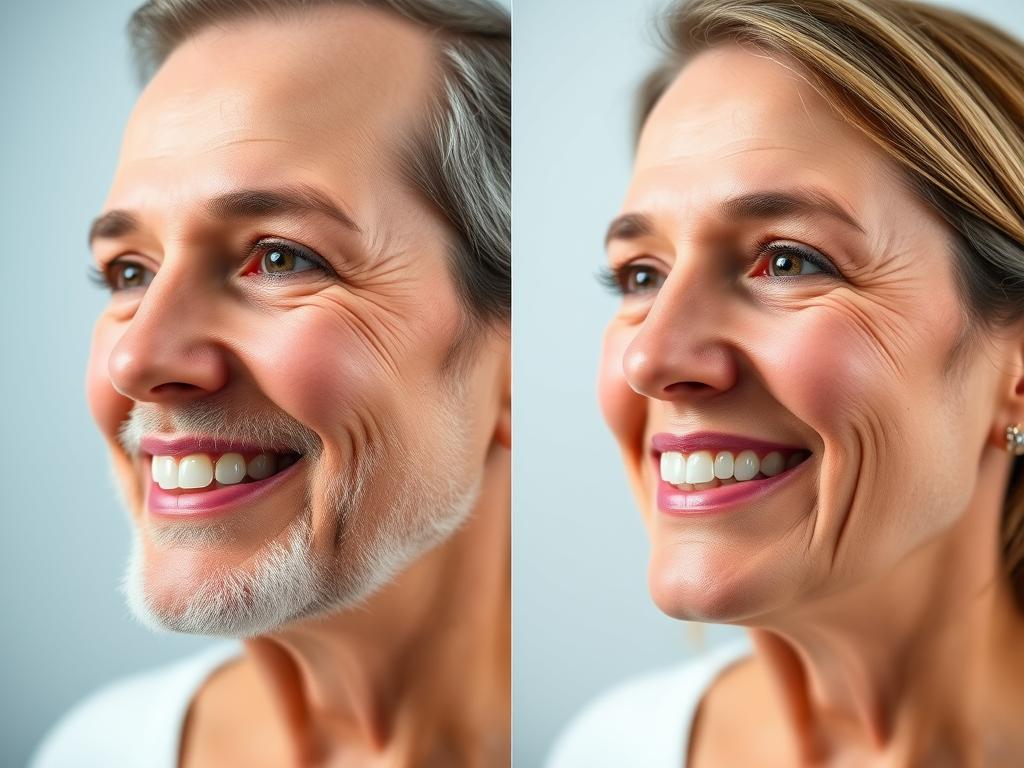Transosteal implant represent a specialized dental restoration solution for patients with insufficient jawbone density. Unlike conventional dental implants, transosteal implants feature a unique design where titanium posts penetrate through the entire jawbone and attach to a metal plate secured beneath the mandible. This comprehensive guide explores everything you need to know about transosteal implants—from their design and applications to surgical procedures and long-term outcomes.
What Are Transosteal Implants?

Transosteal implant structure with posts penetrating through the jawbone
Transosteal implants are biocompatible dental devices designed to replace missing teeth in patients with severe bone resorption. The term “transosteal” derives from “trans” (through) and “osteo” (bone), indicating their distinctive placement method—passing completely through the jawbone rather than just embedding within it.
These implants consist of threaded posts that penetrate both the top and bottom cortical bone plates of the mandibular region. The posts extend through the oral mucosa to provide stable support and attachment points for dental prostheses. A metal plate is secured at the bottom of the jawbone, with screws passing through the bone and exiting in the oral cavity to support dentures or other restorations.
Transosteal implants are primarily used in the lower jaw (mandible) and serve as an alternative solution when traditional endosteal or subperiosteal implants aren’t viable due to insufficient bone volume or density. Pterygoid Implants
Not Sure If Transosteal Implants Are Right For You?
Schedule a consultation with a dental implant specialist to discuss your specific case and explore all available options for restoring your smile.Schedule Free Consultation
Historical Development and Modern Advancements

Transosteal implants have evolved significantly since their introduction to dental restoration. Initially developed as an alternative for patients with severe mandibular bone loss, these implants represented an innovative approach to dental restoration when conventional methods weren’t feasible.
The early designs of transosteal implants featured relatively simple frameworks with limited customization options. However, modern advancements in materials science, imaging technology, and surgical techniques have transformed these devices into highly sophisticated, patient-specific solutions.
Key Milestones in Transosteal Implant Development:
- Introduction of titanium as the primary material, offering superior biocompatibility and osseointegration properties
- Development of 3D imaging and computer-guided implant planning for more precise placement
- Integration of additive manufacturing (3D printing) to create customized implant frameworks
- Refinement of surgical protocols to reduce invasiveness and improve recovery outcomes
- Introduction of surface treatments to enhance osseointegration and long-term stability
Today’s transosteal implants benefit from these technological advancements, offering improved success rates and patient outcomes compared to earlier generations. Modern manufacturing techniques allow for the production of customized titanium implants with intricate surface designs, including porous structures and bioactive coatings that promote better integration with the jawbone.
Key Design Features and Materials

Structural Components
Transosteal implants feature a distinctive design with several key components working together to provide stability and support for dental prostheses:
- Threaded Posts: Titanium rods that penetrate through the entire jawbone, providing the primary support structure
- Baseplate: A metal plate secured at the bottom of the jawbone that anchors the entire implant system
- Abutments: Connectors that attach to the exposed portions of the posts and serve as attachment points for prosthetic teeth
- Stabilizing Screws: Additional fasteners that secure the baseplate to the underside of the jawbone
Materials Used in Transosteal Implants
| Material | Properties | Advantages | Usage |
| Titanium | Biocompatible, corrosion-resistant, high strength-to-weight ratio | Excellent osseointegration, non-toxic, durable | Primary material for posts and baseplate |
| Titanium Alloys | Enhanced mechanical properties, reduced modulus | Improved strength, better stress distribution | Framework components requiring additional strength |
| Zirconium | White color, high biocompatibility | Aesthetic appearance, reduced plaque accumulation | Emerging alternative for visible components |
Titanium remains the dominant material for transosteal implants due to its exceptional biocompatibility, strength, and ability to integrate with bone tissue. The non-toxic nature of titanium compared to other materials like chromium-cobalt and stainless steel has made it the preferred choice for dental implants of all types.
Surface treatments and coatings are often applied to enhance osseointegration. These may include micro-roughened surfaces, hydroxyapatite coatings, or other bioactive materials that promote bone cell attachment and growth around the implant structure.
Clinical Applications
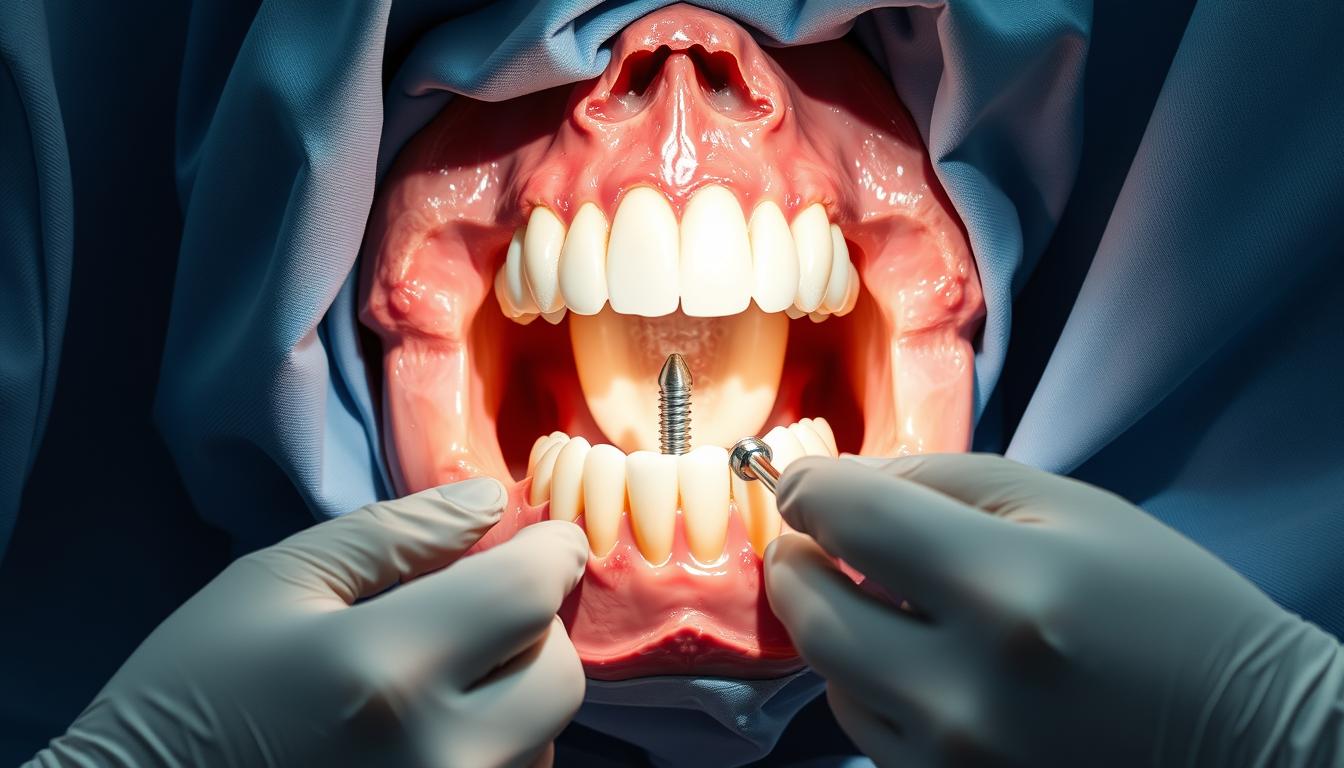
Transosteal implants serve specific clinical needs in dental and maxillofacial reconstruction. While not as commonly used as endosteal implants, they fulfill important roles in specialized cases.
Primary Applications of Transosteal Implants:
Jaw Reconstruction
Transosteal implants excel in cases requiring comprehensive mandibular reconstruction, particularly following:
- Trauma-related jaw deformities
- Mandibulectomy procedures for cancer treatment
- Congenital mandibular defects
The ability of transosteal implants to bypass areas of poor bone quality makes them valuable in complex reconstruction cases where the mandible’s integrity has been compromised.
Severe Bone Resorption Cases
For patients with extensive bone loss in the lower jaw, transosteal implants provide a solution when:
- Traditional endosteal implants cannot be supported
- Bone grafting procedures are contraindicated
- The patient has worn dentures for many years, resulting in significant bone atrophy
By anchoring to both the upper and lower surfaces of the jawbone, transosteal implants can provide stability even in cases of severe bone resorption.
Before and after transosteal implant reconstruction showing functional and aesthetic improvement
According to research published in the Journal of Oral Science and Rehabilitation, transosteal implants have demonstrated a success rate of 74% and a survival rate of 100% after definitive prosthetic rehabilitation. This makes them a viable option for specific patient populations, particularly when other implant types aren’t suitable.
The prevalence of mandible deformities that might benefit from jaw reconstruction surgery is approximately 2% of the population in the United States, indicating a significant potential patient base for transosteal implant procedures.
Advantages and Limitations Compared to Other Implant Types

Advantages of Transosteal Implants
- Enhanced Stability: The through-and-through design provides exceptional primary stability by anchoring to both the top and bottom of the jawbone
- Viable for Severe Bone Loss: Can be used in cases where bone density is insufficient for endosteal implants
- Multiple Teeth Support: Capable of supporting multiple teeth or even a full arch with fewer implant posts
- Reduced Need for Bone Grafting: Can bypass areas of poor bone quality, potentially eliminating the need for extensive bone augmentation
- Longevity: When successfully integrated, titanium transosteal implants can last for decades with proper maintenance
Limitations of Transosteal Implants
- Surgical Complexity: Requires a more invasive and technically demanding procedure than other implant types
- Limited Application: Primarily used in the lower jaw (mandible) with limited options for the upper jaw
- Extended Recovery: The more invasive nature typically results in longer healing times
- Higher Cost: The complex procedure and customized components often lead to higher overall treatment costs
- Maintenance Challenges: The design can make cleaning and maintenance more difficult, potentially increasing the risk of peri-implantitis
Comparison with Other Implant Types
| Feature | Transosteal Implants | Endosteal Implants | Subperiosteal Implants |
| Placement Method | Through the entire jawbone | Directly into the jawbone | On top of the jawbone, under the gum |
| Bone Density Requirements | Moderate (uses both cortical plates) | High (requires adequate volume) | Low (rests on bone surface) |
| Surgical Complexity | High (intraoral and extraoral approaches) | Moderate | Moderate to High |
| Recovery Time | Extended (3-6 months) | Moderate (2-4 months) | Moderate (2-3 months) |
| Versatility | Limited (primarily mandible) | High (upper and lower jaw) | Moderate (custom-designed for specific areas) |
While endosteal implants remain the most common choice for dental restoration, transosteal implants fill an important niche for specific patient populations with unique anatomical challenges. The decision between implant types should be made in consultation with a qualified dental specialist who can evaluate individual patient needs and anatomical considerations.
Surgical Procedure Overview

The placement of transosteal implants involves a complex surgical procedure that requires specialized training and expertise. The following steps outline the typical process for transosteal implant surgery:
Pre-Surgical Evaluation
Before proceeding with transosteal implant placement, a comprehensive evaluation is essential to determine patient suitability and develop a customized treatment plan:
- Diagnostic Imaging: Advanced 3D imaging techniques such as CT scans and cone-beam computed tomography (CBCT) are used to assess bone quality, quantity, and anatomical structures
- Medical History Review: Evaluation of the patient’s overall health status, including conditions that might affect healing or osseointegration
- Treatment Planning: Development of a detailed surgical plan, often using computer-aided design and manufacturing (CAD/CAM) technology to create customized implant components
3D imaging and virtual planning for precise transosteal implant placement
Step-by-Step Surgical Procedure
- Anesthesia Administration: The procedure typically begins with the administration of appropriate anesthesia, which may include local anesthesia, sedation, or general anesthesia depending on the case complexity and patient preferences
- Extraoral Incision: An incision is made beneath the chin to access the lower border of the mandible
- Baseplate Positioning: A titanium baseplate is positioned against the inferior border of the mandible
- Pilot Hole Creation: Precise pilot holes are drilled through the mandible from the bottom to the top, creating pathways for the implant posts
- Post Insertion: Titanium posts are inserted through the pilot holes and secured to the baseplate using specialized fasteners
- Intraoral Exposure: The tops of the posts are exposed through the oral mucosa in the mouth
- Soft Tissue Closure: The extraoral incision is sutured closed, while the intraoral aspects of the posts remain exposed
- Protective Cap Placement: Healing caps are placed over the exposed posts to protect them during the initial healing phase
Post-Surgical Phase and Prosthetic Attachment
Following the surgical placement of the transosteal implant framework, a healing period of 3-6 months is typically required to allow for osseointegration—the process by which the bone tissue integrates with the implant surface. During this time:
- Patients follow specific post-operative care instructions, including medication regimens and dietary modifications
- Regular follow-up appointments monitor healing progress and address any complications
- Once adequate healing and integration have occurred, the protective caps are removed
- Abutments are attached to the exposed posts
- Final impressions are taken for the fabrication of the prosthetic teeth
- The custom-designed prosthesis (which may be a bridge, denture, or set of crowns) is attached to the abutments
The entire process from initial evaluation to final prosthetic placement typically spans 4-8 months, depending on individual healing rates and case complexity. While more time-intensive than some alternatives, the procedure can provide a stable, long-term solution for patients with significant bone loss who might otherwise have limited restorative options.
Case Studies and Success Stories
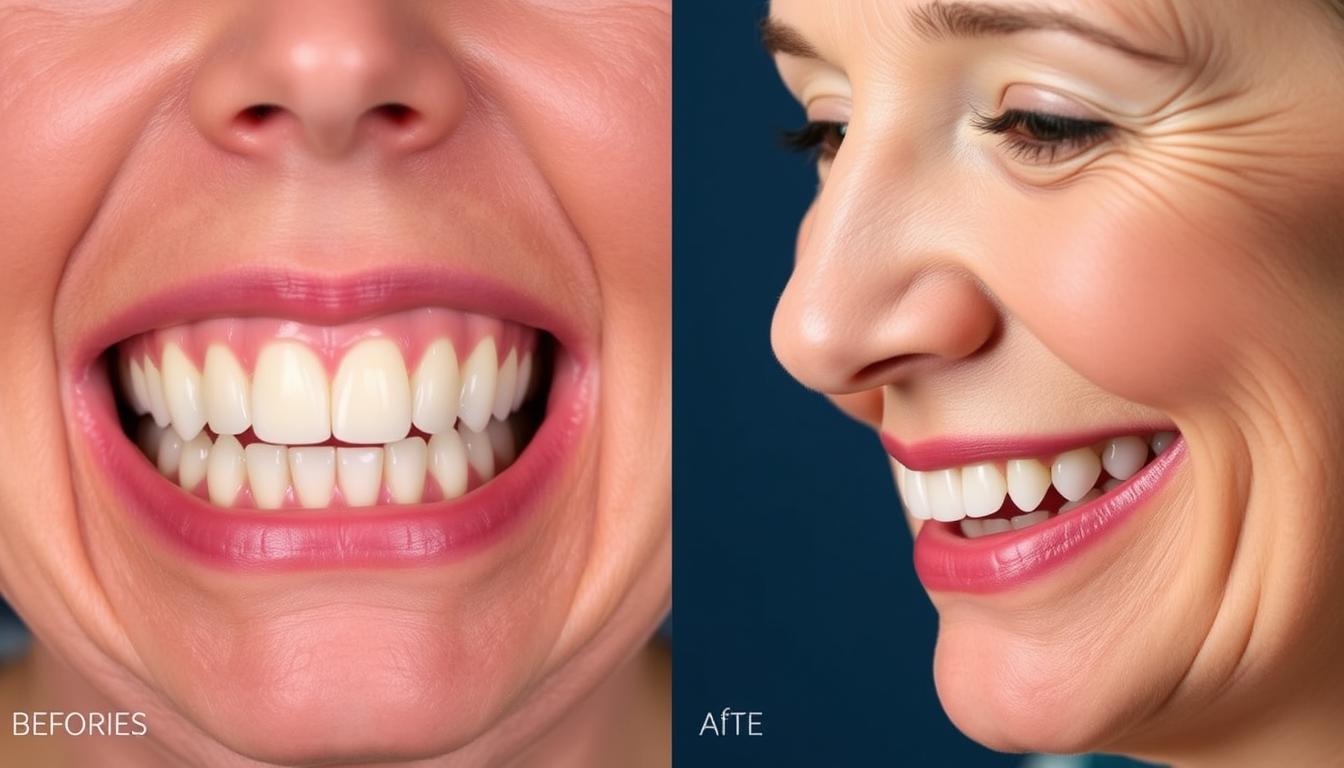
Case Study 1: Post-Trauma Mandibular Reconstruction
Patient Profile: 58-year-old male with severe mandibular bone loss following a motorcycle accident
Challenge: The patient had lost significant bone structure in the anterior mandible, making conventional implants impossible without extensive bone grafting, which was contraindicated due to the patient’s medical history.
Solution: A customized transosteal implant system was designed based on 3D imaging of the patient’s remaining bone structure. The framework included a titanium baseplate with four transosteal posts positioned to maximize engagement with the available bone.
Outcome: Following a 5-month healing period, a fixed prosthesis was attached to the transosteal framework. Five years post-treatment, the patient maintains excellent function with no significant complications. Bone stability around the implant has remained consistent, and the patient reports high satisfaction with both function and aesthetics.
Case Study 2: Severe Atrophy in Long-Term Denture Wearer
Patient Profile: 72-year-old female who had worn complete dentures for over 30 years
Challenge: Extreme mandibular ridge resorption had left insufficient bone height for conventional implants. The patient experienced chronic discomfort and poor denture stability, significantly affecting her quality of life and nutritional intake.
Solution: A transosteal implant system with a custom-designed framework was placed to engage both the superior and inferior cortical plates of the remaining mandible. The procedure was performed under general anesthesia and included careful management of the mental nerve.
Outcome: After a 4-month healing period, an implant-supported overdenture was fabricated and attached to the transosteal framework. The patient reported immediate improvement in stability and chewing function. Three-year follow-up showed stable bone levels and continued prosthetic success.
Radiographic progression showing successful transosteal implant integration over 24 months
Research Findings on Long-Term Success
Clinical studies have demonstrated that properly placed transosteal implants can achieve long-term success rates comparable to other implant types in carefully selected cases:
- A longitudinal study published in the International Journal of Oral & Maxillofacial Implants reported a 5-year success rate of 87% for transosteal implants in patients with severe mandibular atrophy
- Research indicates that patient selection, surgical technique, and prosthetic design significantly influence outcomes
- Factors associated with higher success rates include adequate patient compliance with oral hygiene protocols, absence of smoking, and regular professional maintenance
These case studies and research findings highlight the potential of transosteal implants as a viable solution for specific patient populations, particularly those with severe bone loss who might otherwise have limited options for fixed dental rehabilitation.
Future Trends in Transosteal Implant Technology
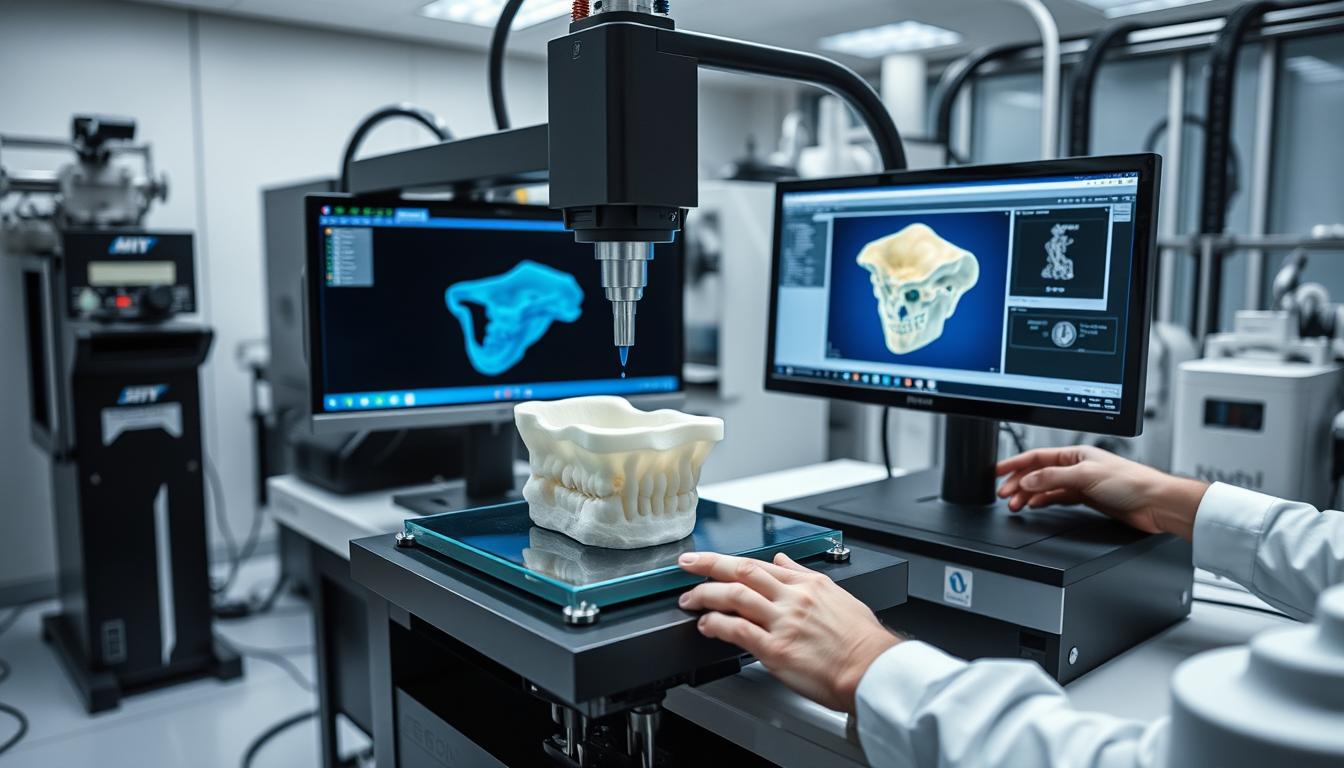
The field of transosteal implantology continues to evolve, with several emerging technologies and approaches poised to enhance outcomes and expand applications:
Additive Manufacturing Revolution
Additive manufacturing, commonly known as 3D printing, is transforming the production of transosteal implants. This technology enables the creation of highly customized implant frameworks that precisely match a patient’s unique anatomy:
- Direct Metal Laser Sintering (DMLS): Allows for the production of complex titanium structures with optimized mechanical properties
- Patient-Specific Designs: Implants can be tailored to the exact dimensions and contours of the individual’s jawbone
- Integrated Features: Advanced manufacturing enables the incorporation of specialized surface textures and porous regions that promote better osseointegration
Companies like Carbon and Structo are expanding their dental 3D printing capabilities, offering solutions that can reduce production time and costs while improving the precision of transosteal implant components.
Bioactive Materials and Surface Treatments
Microscopic view of advanced bioactive surface treatment designed to enhance bone integration
Research into bioactive materials and surface modifications is yielding promising results for improving the integration and longevity of transosteal implants:
- Hydroxyapatite Coatings: Biomimetic coatings that resemble natural bone mineral and promote faster osseointegration
- Growth Factor Incorporation: Experimental approaches involving the addition of bone morphogenetic proteins (BMPs) and other growth factors to stimulate bone formation around implants
- Antimicrobial Surfaces: Development of surface treatments that inhibit bacterial colonization, potentially reducing the risk of peri-implantitis
Computer-Guided Surgery and Digital Workflows
Advanced digital technologies are improving the precision and predictability of transosteal implant procedures:
- Virtual Surgical Planning: Comprehensive pre-surgical simulation allows for precise planning of implant position and angulation
- Surgical Guides: 3D-printed surgical templates ensure accurate transfer of the digital plan to the clinical setting
- Intraoperative Navigation: Real-time guidance systems that help surgeons maintain precision throughout complex procedures
- Digital Impression Systems: Streamlined workflows for capturing the final implant position and designing optimal prosthetic solutions
These technological advancements are collectively working to address the historical limitations of transosteal implants, potentially expanding their application and improving long-term outcomes. As research continues and technologies mature, transosteal implants may see renewed interest as a viable solution for challenging cases of mandibular reconstruction and severe bone atrophy.
Frequently Asked Questions About Transosteal Implants
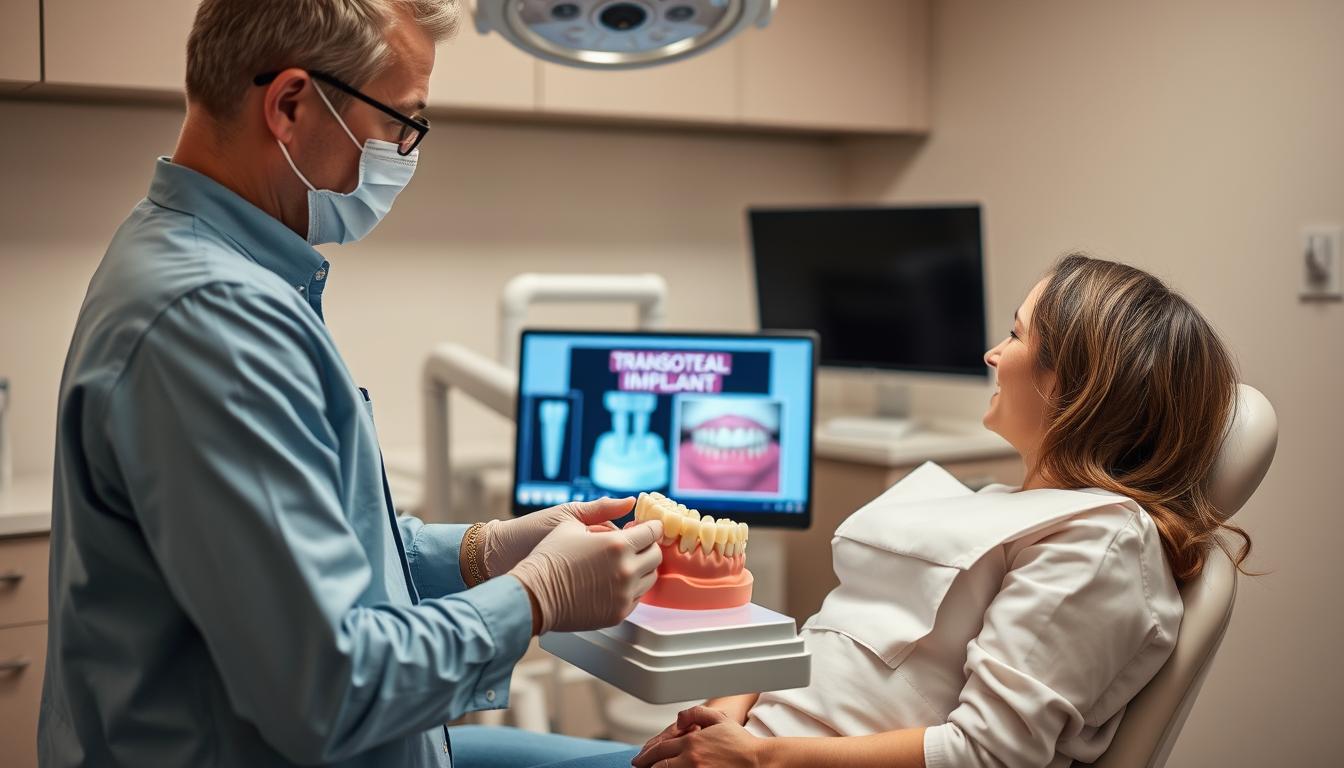
Who is an ideal candidate for transosteal implants?
Ideal candidates for transosteal implants typically include patients with severe mandibular bone loss who are not suitable for conventional endosteal implants. This may include individuals who have experienced significant bone resorption due to long-term denture wear, those who have undergone mandibular resection for cancer treatment, or patients with trauma-related jaw deformities. However, candidates must still have sufficient bone structure to support the transosteal framework and be in good general health to undergo the surgical procedure.
What is the average cost of transosteal implant treatment?
The cost of transosteal implant treatment typically ranges from $5,200 to $13,000 per arch, making it generally more expensive than conventional implant options. This higher cost reflects the complexity of the surgical procedure, the customized nature of the implant components, and the specialized expertise required. Factors affecting the final cost include the number of implants needed, the type of prosthesis attached, geographic location, and whether additional procedures such as bone augmentation are required. Some dental insurance plans may provide partial coverage, though many consider this type of treatment to be elective.
How long do transosteal implants last?
When properly placed and maintained, transosteal implants can last for decades. Studies have shown success rates of 74-87% over 5-10 year periods. The longevity of transosteal implants depends on several factors, including the patient’s oral hygiene practices, regular professional maintenance, absence of smoking, and overall health status. Titanium’s excellent biocompatibility and resistance to corrosion contribute to the long-term durability of these implants. However, as with all dental implants, periodic professional evaluation is essential to monitor for any signs of complications and ensure continued success.
What is the recovery process like after transosteal implant surgery?
Recovery from transosteal implant surgery typically involves several phases. The initial healing period lasts 2-3 weeks, during which patients may experience swelling, discomfort, and minor bleeding. During this time, a soft diet is recommended, along with prescribed pain medications and antimicrobials. The osseointegration phase follows, lasting approximately 3-6 months, during which the jawbone gradually fuses with the implant surface. Throughout the recovery process, patients must maintain excellent oral hygiene and attend regular follow-up appointments. Complete healing and integration must occur before the final prosthesis can be attached to the implant framework.
Can transosteal implants be used in the upper jaw (maxilla)?
Transosteal implants are primarily designed for and used in the lower jaw (mandible). Their application in the upper jaw (maxilla) is extremely limited due to several anatomical and practical considerations. The maxilla has a more complex structure with various sinuses and less dense bone, making the through-and-through approach of transosteal implants problematic. Additionally, the proximity to critical structures such as the nasal cavity and maxillary sinuses increases surgical risks. For the upper jaw, alternative approaches such as zygomatic implants or conventional endosteal implants with sinus lifting procedures are typically more appropriate options.
What are the potential complications associated with transosteal implants?
Potential complications of transosteal implants include infection at the implant site, which may occur if bacteria accumulate around the implant posts. Surgical complications such as bleeding, nerve damage, or allergic reactions to anesthesia are also possible. Long-term issues may include implant failure due to poor integration with the bone, mechanical problems with the implant components, or inadequate stability. Soft tissue complications like ulceration, tissue irritation, and gum recession can develop around the posts that penetrate through the oral mucosa. The risk of these complications can be minimized through proper patient selection, meticulous surgical technique, and diligent post-operative care.
Conclusion
Transosteal implants represent a specialized solution in the field of dental restoration, offering hope for patients with severe mandibular bone loss who might otherwise have limited options. While not as commonly used as endosteal implants, they fulfill an important niche in complex cases of jaw reconstruction and severe atrophy.
The unique design of transosteal implants—passing completely through the jawbone—provides exceptional stability in challenging anatomical situations. However, this approach comes with increased surgical complexity and specific limitations that must be carefully considered when evaluating treatment options.
Advances in imaging technology, computer-guided surgery, and additive manufacturing are continuously improving the precision and predictability of transosteal implant procedures. These innovations, combined with ongoing research into bioactive materials and surface treatments, suggest a promising future for this specialized implant category.
For patients considering dental implant options, consultation with a qualified specialist is essential to determine the most appropriate approach based on individual anatomical considerations, health status, and treatment goals. While transosteal implants may not be suitable for everyone, they remain a valuable tool in the comprehensive management of complex mandibular rehabilitation cases.
Ready to Explore Your Dental Implant Options?
Our specialists can help determine if transosteal implants or another dental restoration solution is right for your specific case.

